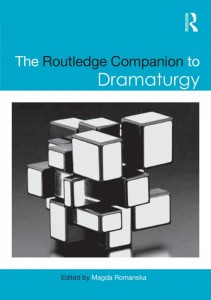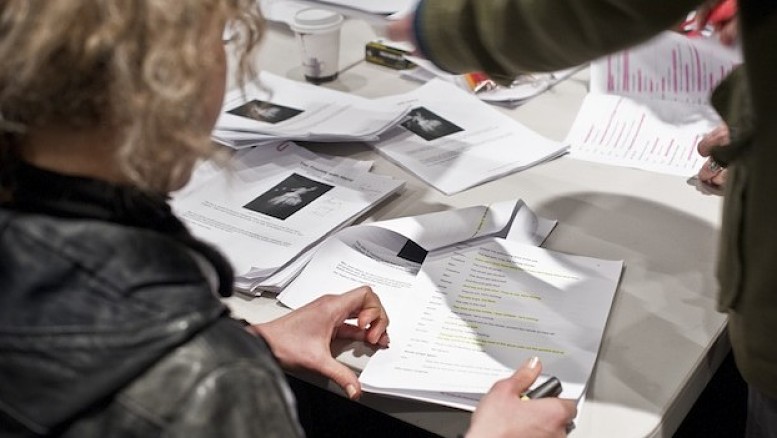The Routledge Companion to Dramaturgy, edited and with an introduction by Magda Romanska, is a timely gift to the world of contemporary theatre. As the newest of collaborative roles in theatremaking, dramaturgy is well established in some performance cultures and still viewed with suspicion in others. At its freest, dramaturgy is a living vein running through a production from its inception, feeding it, constantly exerting pressure, testing it for vitality and truth of emotion, and responding as a reflex to what is being made. The Routledge Companion is a testament to this much-misunderstood practice, and will greatly assist the recognition and consolidation of dramaturgy as an art.

This impressively varied volume includes, in its 8 parts, 85 essays that shine different forms of light on dramaturgical theory and practice. The book may look like a discouragingly large and boring math textbook, but Romanska’s introduction serves as immediate reassurance that books should not be judged by their covers. Her intro is magisterial, managing to address, with astuteness and depth, what dramaturgy was, is, and can be.
One of the book’s highlights is Anne Hamilton’s essay on who dramaturgs are and what they do: cross boundaries, multitask, act as officers of public liaison and conduits for outreach. As someone involved at all levels in the hierarchy of a regional theatre, but typically hired as a contract worker, coming in and out as needed, the dramaturg is both integral and removed, inventing their job on the fly and melding it with the work of institutional outreach and even fundraising. Hamilton aims to inspire dramaturgs to build confidence in their own creative contributions, and to reach deeper, to act more broadly and boldly.
Julie Ann Ward, in her discussion of “theatre of the real” in Brazil, quotes Carol Martin’s definition of such theatre as a way of “forming and reframing what has really happened,” and goes on to consider the dramaturgical task of exploring both data and theatrical space (for example, a biblical piece might be staged in a church, a piece about AIDS in a hospital). Such production elements are intended to complicate the audience’s experience or understanding of the fine line between “what happened” and “what’s made up.” Another essay, “Dramaturgy and Film” by Gerry Potter, leads readers through a brief but active exploration of what cinematic dramaturgy has in common with, and how it is distinct from, some kinds of theatrical dramaturgy.
Of the pedagogical essays, particularly useful is Elinor Fuchs’s “EF’s Visit to a Small Planet: some questions to ask a play.” Writes Fuchs: “A play is not a flat work of literature, not a description in poetry of another world, but in itself another world passing before you in time and space.” Tori Harin-Smith’s “Dramaturging Non-Realism: creating a new vocabulary” arrestingly asks dramaturgs to consider how they think of realistic characters and situations in relation to the concept and practice of non-realism. Anne Cattaneo gives insightful and practical advice to dramaturg wannabes in her “Leadership Advice to a Dramaturgy Student.”

In Brian Quirt’s intriguing essay “New Play Dramaturgy in Canada,” the author observes: “Dramaturgy, to me, is always focused on how a piece is communicated to an audience by whatever means is selected by the artist, and my role is to scrutinize those devices for their effectiveness in communicating the desired ideas to the ultimate spectators.” Graca P. Correa usefully delineates the stages a dramaturg might go through in getting to know a work—the first being that one should note down, on first reading, any texts that come to mind. Correa focuses keenly on issues and choices, political, contextual and otherwise, when approaching adaptation, translation, and editing. D.J. Hopkins’s chapter complements Correa’s by positing the dramaturg as more than a provider of “effectiveness in communicating the desired ideas”; the dramaturg’s role, he contends, should be as a source of dramatic creativity and, at times, subversion.
The premise that the dramaturg should be idea-oriented rather than task-oriented is also developed in Mark Bly’s fine essay, in which he wryly describes the text as a source of strength rather than an invalid to be diagnosed. Blending anecdotes, signposts for helpful dramaturgical pedagogy and process, and evocative references to Billy Collins and T.S. Eliot, Bly’s essay extends the book’s range of thought and demonstrates what can be achieved in spite of (or because of) a brief word limit.
It is that word limit, indeed, that is the source of disappointment in a few of the essays, as some writers offer merely a brief waffle rather than using that space limitation as a challenge to get to the heart of their arguments. Some essays about dramaturgy in various countries (France, Germany, Poland) loosely till the ground for a discussion that never actually takes root. An exception is Pavel Rudnev’s chapter on Russian dramaturgy, which maps the practice along political and cultural lines, mindful of the constraints of censorship on dramaturgy and production. Marjan Moosavi’s chapter on Iran is also fascinating, noting the scarcity of viable texts and thus the emphasis, in Iranian theatre, on adaptation and translation.
Marin Blazevic’s discussion of the “complex in-betweenness of dramaturgy and performance studies” gave me a bit of a shudder—I’m grateful that he advocates for dramaturgy as a practice, but the essay itself is full of big, conjunctivated words that renders it not particularly useful to active dramaturgy. Far more interesting is Romanska’s quirky essay on the relationship between theatre and math. And Michael Chemers’s lovely essay “Phronesis for Robots” extends his important work on defining and mapping dramaturgical practice in Ghost Light, moving on to a discussion of dramaturgy in digital media.
I wish I could comment on all 85 essays—but suffice it to say that you should buy this book or order it for your library, for both the value of its many strengths and the instructive value of its occasional weaknesses. After all, a dramaturg’s job is to read not just with but against expressed idea and convention.
Philippa Kelly, resident dramaturg for California Shakespeare Theater, is currently cowriting a handbook on dramaturgy and diversity for the Literary Managers and Dramaturgs of America with Lydia Garcia of Oregon Shakespeare Festival.


